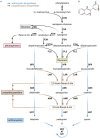Biochemistry and Molecular Basis of Intracellular Flavonoid Transport in Plants
- PMID: 35406945
- PMCID: PMC9002769
- DOI: 10.3390/plants11070963
Biochemistry and Molecular Basis of Intracellular Flavonoid Transport in Plants
Abstract
Flavonoids are a biochemically diverse group of specialized metabolites in plants that are derived from phenylalanine. While the biosynthesis of the flavonoid aglycone is highly conserved across species and well characterized, numerous species-specific decoration steps and their relevance remained largely unexplored. The flavonoid biosynthesis takes place at the cytosolic side of the endoplasmatic reticulum (ER), but accumulation of various flavonoids was observed in the central vacuole. A universal explanation for the subcellular transport of flavonoids has eluded researchers for decades. Current knowledge suggests that a glutathione S-transferase-like protein (ligandin) protects anthocyanins and potentially proanthocyanidin precursors during the transport to the central vacuole. ABCC transporters and to a lower extend MATE transporters sequester anthocyanins into the vacuole. Glycosides of specific proanthocyanidin precursors are sequestered through MATE transporters. A P-ATPase in the tonoplast and potentially other proteins generate the proton gradient that is required for the MATE-mediated antiport. Vesicle-mediated transport of flavonoids from the ER to the vacuole is considered as an alternative or additional route.
Keywords: ABCC; MATE; anthocyanins; flavones; flavonoid accumulation; flavonoid biosynthesis; flavonoid transport; flavonols; ligandin; proanthocyanidins.
Conflict of interest statement
The authors declare no conflict of interest.
Figures



Similar articles
-
MATE2 mediates vacuolar sequestration of flavonoid glycosides and glycoside malonates in Medicago truncatula.Plant Cell. 2011 Apr;23(4):1536-55. doi: 10.1105/tpc.110.080804. Epub 2011 Apr 5. Plant Cell. 2011. PMID: 21467581 Free PMC article.
-
VvMATE1 and VvMATE2 encode putative proanthocyanidin transporters expressed during berry development in Vitis vinifera L.Plant Cell Rep. 2014 Jul;33(7):1147-59. doi: 10.1007/s00299-014-1604-9. Epub 2014 Apr 4. Plant Cell Rep. 2014. PMID: 24700246
-
Differential Roles for VviGST1, VviGST3, and VviGST4 in Proanthocyanidin and Anthocyanin Transport in Vitis vinífera.Front Plant Sci. 2016 Aug 3;7:1166. doi: 10.3389/fpls.2016.01166. eCollection 2016. Front Plant Sci. 2016. PMID: 27536314 Free PMC article.
-
Diversification of Chemical Structures of Methoxylated Flavonoids and Genes Encoding Flavonoid-O-Methyltransferases.Plants (Basel). 2022 Feb 21;11(4):564. doi: 10.3390/plants11040564. Plants (Basel). 2022. PMID: 35214897 Free PMC article. Review.
-
Flavonoid transport mechanisms: how to go, and with whom.Trends Plant Sci. 2015 Sep;20(9):576-85. doi: 10.1016/j.tplants.2015.06.007. Epub 2015 Jul 20. Trends Plant Sci. 2015. PMID: 26205169 Review.
Cited by
-
Identification of key genes responsible for green and white colored spathes in Anthurium andraeanum (Hort.).Front Plant Sci. 2023 Sep 6;14:1208226. doi: 10.3389/fpls.2023.1208226. eCollection 2023. Front Plant Sci. 2023. PMID: 37745994 Free PMC article.
-
Anthocyanin gene enrichment in the distal region of cotton chromosome A07: mechanisms of reproductive organ coloration.Front Plant Sci. 2024 Apr 18;15:1381071. doi: 10.3389/fpls.2024.1381071. eCollection 2024. Front Plant Sci. 2024. PMID: 38699538 Free PMC article.
-
Hesperidin as a Species-Specific Modifier of Aphid Behavior.Int J Mol Sci. 2024 Apr 28;25(9):4822. doi: 10.3390/ijms25094822. Int J Mol Sci. 2024. PMID: 38732039 Free PMC article.
-
Characterization of Triterpene Saponin Glycyrrhizin Transport by Glycyrrhiza glabra.Plants (Basel). 2022 May 5;11(9):1250. doi: 10.3390/plants11091250. Plants (Basel). 2022. PMID: 35567251 Free PMC article.
-
Genome assembly of Musa beccarii shows extensive chromosomal rearrangements and genome expansion during evolution of Musaceae genomes.Gigascience. 2022 Dec 28;12:giad005. doi: 10.1093/gigascience/giad005. Epub 2023 Feb 21. Gigascience. 2022. PMID: 36807539 Free PMC article.
References
-
- Afendi F.M., Okada T., Yamazaki M., Hirai-Morita A., Nakamura Y., Nakamura K., Ikeda S., Takahashi H., Altaf-Ul-Amin M., Darusman L.K., et al. KNApSAcK Family Databases: Integrated Metabolite-Plant Species Databases for Multifaceted Plant Research. Plant Cell Physiol. 2012;53:e1. doi: 10.1093/pcp/pcr165. - DOI - PubMed
Publication types
LinkOut - more resources
Full Text Sources

